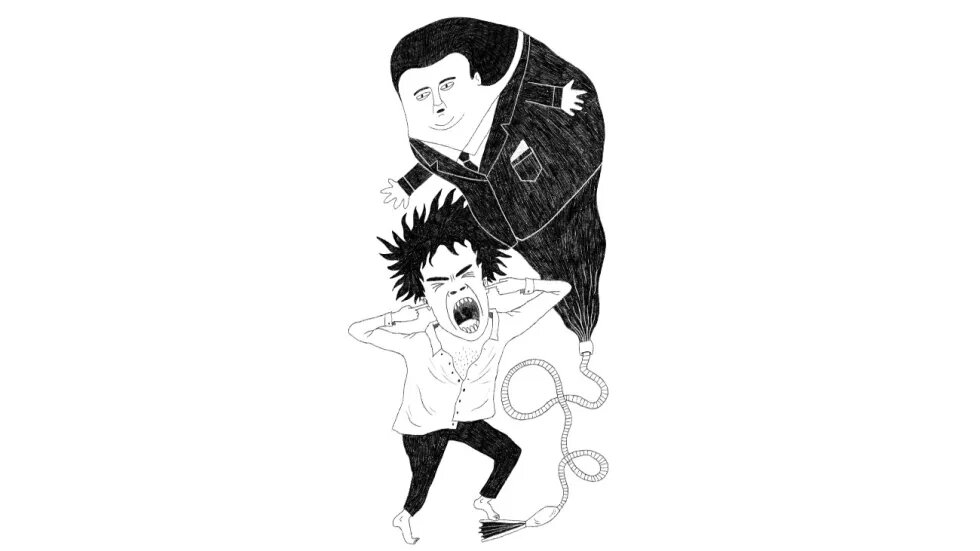The first in a series of essays dedicated to the phenomenon of what is known as the culture wars of Central Europe explains the concept in its original American context, as well as its shift to Europe. This kind of conflict, unlike a historical dispute or ideological debate, is primarily about power.

The Czech Republic has recently caught up with the rest of Europe. In Czechia, too, public arguments, provocations, and debates now concern irreconcilable views on questions of values, norms, and symbols. But these culture wars commenced neither with the Czech president’s outrageous, transphobic comments on the CNN Prima NEWS program, nor, for that matter, with last year’s argument about whether or not a Marian column should be re-erected on Prague’s Old Town Square. Conflicts over values and cultural symbols have been with us ever since the Velvet Revolution.
Several years ago, however, they took on a radically different face. Not only do they now successfully suppress debates about party platforms, but they also divide the public into mutually hostile groups. The current culture wars are characterized by two attributes: polarized, principal-based attitudes to a specific value or symbol that cannot be reconciled through a compromise, and an aggressive, militant style of debate with the aim of defeating the opponent, rather than enforcing a specific solution to an issue, as used to be the case in politics “as usual”.
Although mostly waged over seemingly local issues, culture wars are a decidedly global phenomenon. And despite pertaining to ideas and values, they flare up the most intensely once aligned with the struggle for political power. These are at least the theses of the present article, opening a series of reflection essays on the recent culture wars in the Czech Republic and surrounding areas. The text chiefly engages with the concept of culture wars as such and the different forms and shapes they acquire in the Central European region, as well as their political logic.
A Battle for the Soul of America
The concept of culture wars dates as far back as the 1990s in the United States, but it is linked to an even older phenomenon, which has recently regained its full force and found an expression in European politics. Due to the many parallels with the present day, the American genealogy of culture wars is therefore worth exploring.
In 1991, American sociologist James Davidson Hunter published Culture Wars: The Struggle to Define America. The book put forth a diagnosis of conflicts that strongly impacted the American politics of the 1980s, but which had already been taking place since the 1960s. In these, a network of conservative Evangelical churches and their political allies clashed with intellectuals, artists, and liberal politicians seeking to reform racist American laws and underpin social liberalization with political and legal recognition.
Those culture wars reflected two trends: a reaction to racial desegregation and liberalization, and a fundamental rearrangement of the American political scene. The resistance to desegregation involved, for instance, the question of whether privately funded schools continuing the whites-only segregation practice were eligible for state funding. The opposition to the liberalization of federal policies later resulted in hundreds of local mobilizations against the teaching of evolution and sex education, and arguments over both the army’s attitude toward homosexual soldiers under the Clinton administration and the legal recognition of same-sex marriage circa the year 2008. Another whole chapter could be written about wars waged over gender equality laws and the resistance to abortion led by the “Pro-Life” movement, the latter of which combined civic activism, campaigning, sabotage, and at times even violence.
However current these affairs may sound, they were already climaxing in the 1980s and 90s, which, besides the above-mentioned social and cultural transitions, saw important change in political terms, too. Suddenly, the Democratic Party no longer represents the “people’s”, working classes, whose well-paid, union-protected jobs are becoming precarious due to de-industrialization. Blue-collar workers are taken under the wing of the traditional bastion of the moneyed, the Republican Party. In the 1980s, the charismatic Ronald Reagan comes with the promise of a return to the good old America, with its pioneering, individualistic self-sufficiency, its faith in God and the market, and its distrust in the government. Generously designed social and infrastructural policies that both parties had been building since the 1960s are being significantly streamlined. The renewed liberalism takes on a cultural guise – the free America wins the Cold War, and the faith in a simple, cultural, and neoliberal formula for the restoration of the Golden Age attracts the conservative and blue-collar part of society to the Republican camp. The American political scene gradually switches its magnetic poles. The Democrats cease to be a socially oriented party of workers and become a liberal party of the cities and minorities, while also embracing market liberalism. The Republicans have the support of powerful Evangelical churches, rural areas, and former industrial centers. The earlier socio-economical fission gives way to cultural polarization.
James D. Hunter defines the culture wars as a clash between two different value systems over the moral ground of America – biblical foundations versus secularism, and orthodoxy versus progressivism. What makes Hunter’s approach interesting is that one side of the culture wars brings together the formerly feuding Evangelicals and Catholics, united over their orthodox or fundamentalist orientation, while the other one connects believers of various confessions, including Muslims, whose political positions are secular, based on the idea of social progress and the moral autonomy of the individual. Another remarkable feature of Hunter’s take on the culture wars is the assertion that later came to be supported by a number of other commentators: this kind of division is not a social phenomenon. It has been evident from the start that there were no two clearly defined groups, since on individual issues, Americans were still able to take very diverse stances. Hunter himself saw cultural polarization as an effect of cultural warfare which had been taken up by the political and media elites.
An illustration of this might be the case of Pete Buchanan, an ultraconservative politician who used Hunter’s concept in his campaign for the Republican presidential nomination: “There is a religious war going on in this country for the soul of America. It is a cultural war, as critical to the kind of nation we shall be as the Cold War itself.” Buchanan claimed that “when many of us were young, public schools and Catholic schools, Christian schools and Jewish schools taught children about their religious heritage and the Judeo-Christian values, they taught them what is right and what is wrong. We were taught about the glory and the adventures of this country that we call the God’s country, which we are all lucky to live in (…), but nowadays there are too many schools in which children lose their innocence. Children are poisoned and turned against their Judeo-Christian heritage, against the American heroes, and against the American history, against the values of faith, family, and country.” The poison that Buchanan referred to was the reflexive criticism of the liberals, coming to terms with the heritage of slavery, racism, and sexism. And Buchanan himself entered into this war by declaring that “we will fight and win the culture war for the soul of America”.
The European Culture Wars
Culture wars are thus ambiguous from the very start. They give the impression of arising from a profound cultural cleft, but it is a cleft that cultural warriors themselves deliberately deepen. Would the polarization be as profound were it not for cultural warriors in politics and the media, or has society structurally changed so much that it has become easy and cheap to unleash a culture war? The European case confirms this ambivalence. In Europe, too, substantial cultural and social change is exploited and politicized by cultural warriors.
In Europe, the cultural clashes are not altogether new either. The first all-European cultural debate, which has divided Europe into Catholic and secular states, was triggered in 2003 by the question of whether the European Constitution, then under preparation, and ultimately never adopted, should contain the word God, or merely a reference to the European Humanist tradition. Other cultural debates concerned euthanasia and assisted reproduction, both of which were seized by the Christian democrats as topics that came to define them in a secularizing Europe. Back then, however, debates over historical and bioethical issues were still led in a controversial yet civil manner.
After 2010, controversies in Europe saw (mostly in retrospect) a turnabout from civil to militant. Cultural issues became the subject of mass mobilization, petition campaigns, and debate wars. The first major mobilizations on this battleground took place in 2011 and 2012 in France, where the intended bill on same-sex marriage sparked the formation of the “Protest for All” movement (La Manif pour tous – LMPT). LMPT was not simply a fundamentalist project, as it was also supported by common right-wing conservatives. Protests, some of them joined by up to hundreds of thousands, were a huge mobilization success – the fragmented right-wing opposition united over an issue that had until then rested on the margins of public attention. A similar logic of the temporary harmonization of fundamentalist and conservative interests would later repeat itself in all important mobilizations against same-sex marriage.
Although LMPT did not succeed, Holland’s government having eventually passed the bill, the movement served as proof of the mobilization potential of the cultural brand of conservative politics. Within a year, branches of the movement shot off in a number of European states. They shared its secular language and positive vocabulary, as well as its pink-and-blue logo. Slogans such as “Mom and dad, equal and complementary”, and “Less gender, more sex” sounded harmless enough in 2013, but later became instrumental in a covert culture war. As early as in 2013, Croatian Catholic activist Željka Markić manages, with the aid of the church, to assemble nearly 750,000 signatures in favour of a referendum that proposes a constitutional bar to same-sex marriage, a bill that eventually wins the support of the majority of Croatian voters. Such referendums are then unsuccessfully repeated in Slovakia (2015) and Romania (2018), always in a situation when a right-wing opposition, backed by the Catholic church, mobilizes against a (nominally) leftist government. This convenient political context endowed the “value” arguments with an almost warlike dimension – massive mobilizations for a symbolic result, creating two more or less stable warring groups, a liberal leftist and a conservative nationalist one.
The year 2013 also uncovered the growing strength of the organized conservative Catholic civil society and the support it enjoys from the American Evangelicals. Mobilizations in 2012 and 2013 were organized on social media using activist methods, until then developed by the progressivist and liberal civil society. Petitions, lobbying, legal disputes, annual marches, and summer schools, but also specific branding including logos, colours, and slogans, became the tools of a professionalized conservative activism. In 2012, the organization One of Us set in motion a European Citizens’ Initiative (ECI), whose aim, in the case that it won enough support, was a legislative proposal for the European Parliament to curb the funding for organizations that support abortion and embryo destruction. Backed by Pope Benedict, the ECI managed to collect 1.7 million signatures. In Europe, One of Us, a European branch of the global “Pro-Life” movement, used a procedure already tested out in the US: a gag law proposal that would ban state funding for organizations labelled as immoral.
Although the initiative did not succeed, the European Commission having stated that the ethical standards of stem cell research are anchored in law, it did help a mobilization that united Italian politicians, the Vatican, Catholic civil society, and American Evangelical lobbyists. Since 2013, anti-abortion protests have been regularly held all over Europe, including in the Czech Republic. And it is Central Europe in particular whose social climate has been transformed by different kinds of cultural arguments the most profoundly.
The Central European Culture Battlefields
The culture wars of the aforementioned type eventually arrived in Central Europe, too – along with the controversies surrounding what is known as the Istanbul Convention in Poland, same-sex marriage in Croatia, and the so-called gender ideology, as labelled by Catholic bishop conferences in 2013. Compared to Western European countries, Central Europe has been marked by a strong politization of these issues, particularly in times of polarizing elections. In Slovakia in 2018, and in Poland in 2020, the main debates involved the alleged liberalism of the presidential candidates, and their attitudes toward homosexuals; Poland and Slovakia are divided by attempts to put a complete or near-ban on abortion, and the populists in Hungary and the Czech Republic publicly and systematically agitate against trans people and homosexuals.
What sets Central Europe apart from the West, however, is hardly Catholic tradition or religious zeal. The culture wars have been unleashed even in relatively secular or multi-confessional countries such as Czechia and Hungary. The difference lies in the context, in which conservative mobilization constitutes merely the last one of several culture wars. In fact, arguments over liberal values are inseparable from a whole range of other conflicts that preceded or followed them, since on numerous levels they are intertwined. The culture wars may be classified according to three types of politics.
The first is the politics of memory. The relationship to the past was the first issue around which polarized opinion camps were formed, particularly regarding the communist or World War II legacies. Controversies around the culpability for (or complicity in) crimes against the Jews in Poland, the Nazi symbolism in Slovakia, the rehabilitation of Horthy’s regime in Hungary, and historical revisionism and the Ustasha state in Croatia are examples of what are called memory wars, in which nationally inclined politicians, journalists, and activists fight against the critically thinking ones.
The second type of culture war is fought on the battlefield of the politics of identity. The critical year of 2015 led to an unpredictable polarization of society in relation to migration and Islam. In virtually all Visegrad countries, the debate revolved around the nature of Islam and the alleged threat it poses to “Christian values”, rather than around practical solutions to what came to be called a refugee crisis. To counter the so-called liberal and pro-European party of the conflict, an opposing group was formed, which, in the name of a then-emergent notion of Europe’s Christian identity and the incompatibility of religion and culture, put national homogeneity before universal principles and European cooperation.
The politics of morality constitutes the last, but so far the most active, battleground of the Central European culture wars. Amidst the arguments about the rights of women, homosexuals, and transgender people, the consensus that a liberal democratic state should grant people freedom and equality regardless of their individual characteristics quickly falls apart. Reproductive behaviour, sexual orientation, and education become the subject of a moralizing gaze and a target of calls for state- and church-led regulation, and the recognition of majority norms as moral, at the expense of individual autonomy.
Not even Western Europe avoided controversies surrounding the politics of memory and freedom. In the past decade, some European states have become increasingly open to a complicated reconsideration of their own colonial eras, and almost all of them have been animatedly discussing the rules of the multicultural society which they have, due to post-war labor migration and European mobility, come to be. In the West, however, the process of historical reckoning has been a gradual one, and serious debates on multiculturalism had already culminated by the mid-2000s. In the meantime, most Western European countries abandoned the initial cultural form of the arguments about national character and started to address the issues pragmatically.
In Central Europe, by contrast, several diverse processes were set it motion. One of them was related to the consequences of joining the European Union, after which some Central European political streams lost their goals and visions, and the ideological differences among them started to come to the surface. Central Europe also had to gradually process the symbolic consequences of European integration. Here, the historical memory required a more complex coming to terms with WWII and communism, one that could not be done against the symbolic pan-European backdrop. Liberal social values, expressed in anti-discrimination and minority protection legislation, needed time to be “digested” by civic activism, reforms of public services, and culture, in order to become fully integrated into the public awareness. The polarizing power of cultural arguments fully unfurled after 2015, in a moment of nearly palpable dread of a clash with a complicated world beyond the flimsy borders of Europe.
What characterizes the Central European culture wars is the fact that a number of social order challengers, following the expansion of the EU, were able to use a whole range of polarizing tools in order to advance certain political projects. As both Western and Eastern experience suggests, an open culture war sets in once a populist subject tries to assert their position on the right side of the political spectrum, and conservative liberals adopt their topics and escalate the cultural struggle. In Central Europe, it was successful projects of national conservatism such as Fidesz in Hungary and Law and Justice (Prawo i Sprawiedliwość) in Poland that consolidated the political right through culture wars on all three of the above-described battlefields. The Central European case corroborates Hunter’s assertion about the culture wars being a way of waging a political struggle by discursive means.
The Battle for Hegemony: Towards a Definition
The concept of culture wars is in itself so ambiguous that it might merit the use of inverted commas. On the one hand, it describes cultural clashes, while on the other it is a label exploited to discredit the opponent. It implies warring parties, and at the same time it generates them. In contrast to a historical dispute or an ideological debate, culture wars truly polarize – they push their own participants towards extreme positions on the opinion spectrum, while completely ruling out the possibility to reach a compromise. Unlike arguments and debates, they are directly concerned with power. What is “cultural” (or perhaps uncultured) about them is the fact that they involve fights over definitions, over the assertion of certain terminology through gradually built cultural and political influence, or else over political power, conducted by means of advancing a specific discourse.
The participants in culture wars define a topic – communism, gender, gender equality, liberalism – in a new way, or promote a new perspective on them. Their tools are seemingly ideological. A cultural warrior, however, does not debate and seek the “truth”, but, through mobilization in both physical and virtual spaces, asserts their views and definitions against the opponents’. The introduction of opaque, empty terms (gender theory, cultural Marxism, Islamofascism, a refugee welcomer, but also a xenophobe, an Islamophobe, and a racist) is an instrument of power, if only because of the fact that it successfully destroys an unconscious consensus and discredits the enemy.
Culture wars are still most often waged under the flag of a minority or endangered position, and against an assumed, often artificially constructed dominance. Expressions such as “liberal dictatorship”, “protection of majority rights”, “war against Christians”, “the white male as an endangered species”, and “the rule of political correctness” imply a coercive superiority. That is how the Czech president Miloš Zeman creates the notion of liberal “power” when he deliberately and grossly offends journalists, women, or transgender people, receives criticism for it from the general public, and is then able to claim that the majority asserts their norms against him. The second phase of a culture war consists of seizing cultural institutions and advisory boards (of universities and media in Poland and Hungary, of media councils), and the attempts to occupy positions of power by people united under a certain cultural code (resistance to gender, migration, the EU).
The struggle for cultural hegemony, described in the 1920s by the Italian Marxist Antonio Gramsci, has attracted even far-right theorists. Alain de Benoist uses the term metapolitics for the “domain of values” which drives the social consensus, and it is precisely the seizure of the sources of social consensus that constitutes the Gramscian path toward assuming political power. “Culture wars” are not just harmless cultural arguments. They are not fights over values, but rather for values and concrete symbols that encode the orientation of a group. They need to be critically analyzed precisely for the public domain to remain an open space for the struggle over values.
/This essay has been written in cooperation with Heinrich-Böll-Stiftung Prague and published in Czech in the A2 magazine, issue 14-15/2021. Author's opinions do not have to reflect the positions of HBS. Translated by Alžběta Ambrožová/


